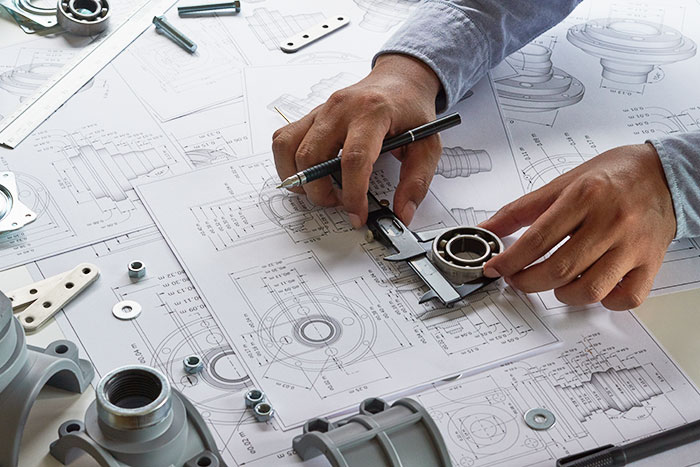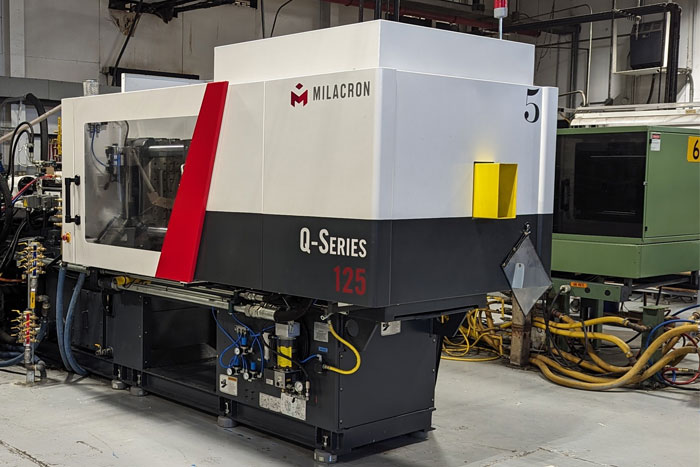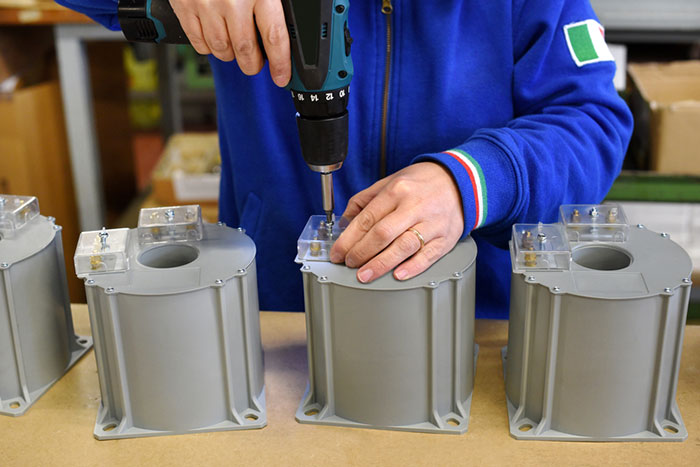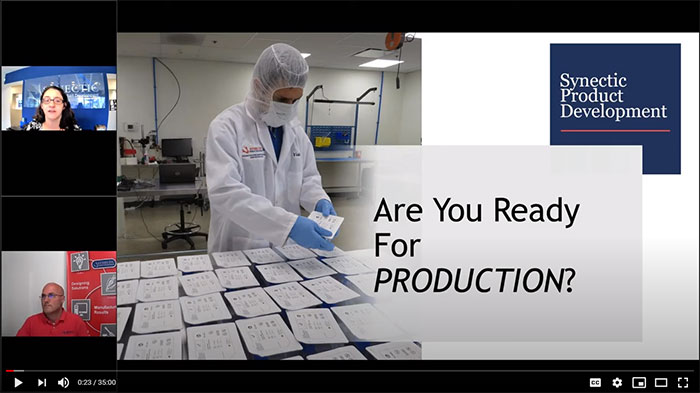
DFM stands for Design for Manufacturing or Design for Manufacturability and is also sometimes referred to as DFMA, where the A represents Assembly. This manufacturing process occurs during the product development process when your design shifts from prototype development to new product introduction. When done correctly, it significantly lowers the cost and time of manufacturing components. In this article, we discuss all you need to know about DFM and how it affects the manufacturability of your product.
What is DFM?
Design for Manufacturing or Design for Manufacturability (DFM) involves optimizing parts and component design to ease manufacturing and assembly. It is an approach to product design that aims to minimize manufacturing costs while maintaining or improving product quality, functionality, and reliability. Due to years of manufacturing experience, most seasoned engineers build some design for manufacturing work into earlier parts of the product development process. However, the design for manufacturing process is so detailed that its effort requires its own phase.
There is an optimal time for DFM as it can be costly when done too late in the product development process. At Synectic, the sweet spot for beginning DFM is when the mechanical engineering team feels confident in the design’s functionality, generally after vigorous prototype development and testing.
What are the principles of DFM?
At Synectic, we follow six DFM principles to identify and solve design issues that could affect product quality. Following these principles has many benefits, such as optimizing the design for manufacturing, making the production process efficient and cost-effective, and maintaining high-quality standards. If you follow the process correctly, you will end up with a reliable and high-quality product that increases customer satisfaction and loyalty. Therefore, when performing DFM, we recommend you follow these six principles:
- Minimize part count by eliminating or combining them if possible. Additionally, you want to reduce part complexity where possible. Doing so will reduce your manufacturing costs.
- Design for assembly by including modular design, snap-fit components, and other features that enable quick and easy assembly. These changes make the manufacturing process efficient with a high level of repeatability, reducing the risk of production errors.
- Design for manufacturability by optimizing the parts for the chosen manufacturing process, whether plastic injection molding, casting, or stamping. Optimizing the parts for manufacturing will produce a more reliable product since there will be less chance of production errors.
- Design for testability by including features that make it easy to access test points and monitor product performance during testing.
- Design for cost reduction by changing the materials used, the manufacturing process, or tooling to more cost-effective options.
- Design for flexibility by including modular design and standard components, making it easier to change the design without starting from scratch.
How long does the DFM process take?
In our experience, the DFM process can take anywhere from a few weeks to several months. This mostly depends on the product design’s complexity and your development team’s size. Additional factors such as the number of iterations required for optimization, the availability of information, and what DFM tools your team uses also come into play. Therefore, we recommend you plan for a longer time frame than expected. It is better to take your time during the DFM process than to rush and find out later that you missed a crucial step once you begin manufacturing.
How do you perform a DFM analysis?
DFM analysis is a systematic process that evaluates the product design and identifies any areas that may impact the manufacturing process. Performing a DFM analysis is an art because manufacturing engineers must gently balance multiple factors to lower costs without sacrificing quality. By incorporating DFM principles into product design, you can achieve better outcomes and create high-quality products that meet customer expectations. Here are some guidelines we follow when performing a DFM analysis on your product design:
- Review and understand the design intent.
- Select materials that meet the design requirements while keeping in mind all cost-adding processes.
- Decide on a final manufacturing process for each part based on part geometry and projected volumes.
- Design parts so that selected stock sizes minimize material removal to reduce machining time.
- Carefully review tolerances for proper fit, form, and function and determine the loosest possible values. Part tolerance should allow for a good product using the chosen manufacturing method.
- Review the complexity (cost) of a single part versus the assembly time for multi-part assemblies.
- For plastic injected molded parts, review wall thickness, draft, ribs, and texture for uniformity and consistency in the molding process.
- Review the design of assemblies with careful attention to assembly order, number of parts, and assembly time required.
- When products contain electronics, review safety requirements for both the assembly process and the end-use by the customer.
- Review proper product labeling to minimize risk and adhere to regulatory and industry requirements.
- Minimize the number of different sizes of hardware needed, thus reducing the tools required.
- Minimize the number of assembly fixtures and jigs.
- Make part tolerances easy to measure during the incoming inspection, and avoid making components that need sectioning when measured.
What questions should you ask when designing for manufacturability?
While going through the design for manufacturing process above, Synectic’s DFM engineers ask themselves a series of questions. The questions inspire the DFM team to devise alternative solutions that maximize product manufacturability. These questions include:
- What materials are required for the product, and are they readily available? Does the product require sterilized or biocompatible materials? If not, are there cheaper alternatives available?
- What manufacturing processes are we planning on using? Is there a way to convert metal parts to plastic to utilize plastic injection molding? Are there alternative manufacturing processes, such as urethane casting for small part volumes? How can we streamline the number of processes and steps?
- What tooling is necessary, and how does it impact production cost? What alternative tooling methods or features would decrease tooling costs? Would a multi-cavity mold be a better solution?
- How will the product be assembled, and how many people on the assembly team will be required? What are some ways to reduce the number of assembly steps?
- How will the product be tested and inspected? How can we alter the design or features for easier testing and inspection?
- What fixtures and jigs are necessary? Where can we cut down the number of fixtures and jigs to only include them at essential checkpoints?
- What tolerances and dimensional accuracy does the product require? What are the loosest tolerances that still allow for a quality product?
- What secondary operations or finishing processes are necessary? Can we eliminate some of these final operations by changing materials or fabrication methods?
What are some DFM tools?
Design for manufacturing involves optimizing the product design to reduce the cost and complexity of the manufacturing process while maintaining the desired product quality and performance. To do this, a design manufacturer will use several tools to support the DFM process, including:
- Design software, such as SolidWorks, Pro/Engineer, or AutoCAD, creates detailed 3D models of the product and simulates the manufacturing process.
- Cost estimating tools, such as QuickCost or ESTic, estimate the cost of the manufacturing process, accounting for the materials used, the manufacturing processes, and tooling costs.
- Process simulation tools, such as Moldflow or Pro/Mold, simulate the molding process and predict product performance to identify any potential issues with the molding process.
- Finite element analysis (FEA) tools, such as Ansys or Abaqus, analyze the product design and predict product performance under different loads and conditions, identifying potential weaknesses in the design.
- Quality management tools, such as Minitab or JMP, analyze the data collected during testing and inspection, identifying any quality issues.
- Collaboration tools, such as Microsoft Teams or Slack, facilitate communication and collaboration between the design and manufacturing teams.
What can affect design for manufaturing?
Remember, the goal of doing a DFM is to optimize the design to ease manufacturing and assembly without compromising quality. Several factors can affect design for manufacturing. Here are just a few of the factors we focus on at Synectic.
Cost
Cost drives every move made during the DFM process, as the goal is to minimize the cost of the manufacturing process while maintaining the desired product quality and performance. Production cost influences everything from materials selection to manufacturing and assembly processes to tooling. It is common knowledge in manufacturing that over 70% of production costs are affected by design. Therefore, even simple design changes, such as using standardized components and hardware, can greatly decrease your cost.
Manufacturing process
Next to cost, the manufacturing process is probably the second most significant driver of design for manufacturing changes. When performing a DFM analysis, you must account for the different capabilities and limitations of different manufacturing processes, such as injection molding, casting, or stamping.
If you carefully design a machined part to minimize the number of setups, it can keep the cost low. For example, if all the machining occurs on one side, it eliminates the need to unclamp and reposition to another side, thus reducing time and labor costs.
Component designers can also minimize the cost of machined parts by reducing the number of tool changes required. For instance, if all the radii are the same and large enough, you can use the same endmill to remove material and generate the filets in the corners, eliminating the need for tool change. Using the same size holes or tapped holes throughout the part also can minimize tool changes.
Another option during DFM is eliminating secondary operations requiring moving parts to another machine. An example is a lathe part that has details completed on a milling machine or an EDM (Electrical Discharge Machining) machine. With the advancement of CNC machining centers and the addition of fourth and fifth-axis machines, this has become less of a factor, although not all machine shops have these newer machines.
Required tolerancing
Reviewing tolerancing is a necessary aspect of DFM. The tolerancing of a part affects not only pricing but product assembly, manufacturability, and function. Components should be toleranced to ensure they fit together and function within the range provided on the prints.
Tolerancing goes hand in hand with tooling as it lays out what variations in the product dimensions are allowed before compromising function. For example, if a product requires tight tolerances, it may require specialized tooling, such as precision jigs and fixtures, which can increase the cost of the manufacturing process.
Tolerancing also helps drive the manufacturing process. The tighter the tolerances, the more challenging and expensive it can be to manufacture the product. Tighter tolerances often require more complex and specialized manufacturing processes, such as CNC machining or laser cutting, which increase the cost. Tighter tolerances also cost more to manufacture and lead to higher part fallout. The good news is tighter tolerancing is almost a given with the onset of CNC machining centers. Typically, +/- .005″ used to be the standard, but now +/- .003″ is no more costly due to the precision of machining centers.
The tolerances of a product can affect the testing and inspection process, as tighter tolerances may require more precise testing and inspection techniques, which can increase the cost of the manufacturing process. The parts should be toleranced so they can be easily verified when inspected. An excessive number of dimensions or very tight tolerances on parts can cause inspections to take longer and cost more.
Material selection
The materials used in the product can also impact the DFM process, as different materials have different properties and may require specialized manufacturing processes. Material selection determines raw material cost and machining feed rates which directly impacts production time. The designer should consider the material properties, such as strength, durability, and hardness, to ensure you are using the correct materials.
With many products today being electro-mechanical, the design of printed circuit boards and component selection is critical. Carefully consider the availability of components when selecting materials, as obsolesce is a costly issue. Component heat transfer requirements can impact the performance and function of many electronic boards.
Thermal analysis and safety are also aspects of the DFM review of electronics. A review of product performance verification is necessary to assure the safety of the assemblers. While this relates primarily to hardware, software generally also gets a close inspection. Testing and certification of products can have a significant impact on cost. However, they are usually one-time certifications (CE or UL) with a single upfront cost.
Assembly process
Ease of assembly impacts the DFM process, as a difficult to assemble product increases manufacturing time and cost. Engineers should optimize the design for assembly incorporating features that make it easy for the manufacturer to put the product together. The simpler a product is to assemble, the more cost-effective it will be.
With the rising cost of labor, you need to consider assembly time. If simplifying a part changes one part into multiple parts, requiring assembly, you must weigh the part cost savings against the costs of adding assembly time and necessary hardware. Conversely, moving to a single complicated part may save money if it eliminates the need for alignment fixtures or jigs. All these factors need evaluation during design for manufacturing.
Testing
The design should be optimized for testing and inspection, incorporating features that make it easy to access test points and monitor product performance during testing. Testing and inspection ensure that the product meets the desired quality standards and identifies and quickly resolves any issues.
Using standardized parts when possible helps save money on incoming inspections. Another way to optimize for testing and inspection is to make a zero-corner part. A zero-corner part gives the inspection team a definite starting location for taking measurements. The downfall is that these parts are limited in geometry and features.
Part quantity
It comes as no surprise that the quickest way to reduce cost is to reduce the number of different parts produced. Depending on the function and user requirements, this may not be possible, but there are a few strategies for lowering part quantity without sacrificing product quality.
A common strategy is combining smaller components into one large plastic part. Similarly, modular assemblies let you add extras to different product models without increasing part production for all units. Look at the components and see if you can use the same part in multiple places, such as using the one-part design for both halves of an outer case. You can drastically cut your piece part price by producing a higher volume of one instead of smaller amounts of multiple parts. It also can impact inspection and assembly costs as you will not have paperwork and quality controls for separate components.
Expected sales volume
Expected sales volume plays a role in determining part production. If production volumes are high enough, it may make sense to consider molding or casting the part. While both these processes involve substantial tooling expenses, you can reduce piece part price by amortizing tooling costs over the product lifetime.
In some cases, a high-volume part may be initially machined, for the first few months, to allow for the design to stabilize. If there are no part design changes, the production method may transition to molding or casting as a cost-reduction program.
Finish requirements
The finish requirements of a part also affect DFM. Many finishes are available based on material and environmental factors. For example, metal parts will need at least one secondary operation to complete. The simplest option is stainless steel which requires only a cleaning process known as passivation. With aluminum parts, the choices are numerous, with anodizing in several colors, hard anodizing, nickel plating, painting, and powder coating being the most popular.
While we have touched on many aspects of DFM, it is impossible to encompass all the tasks and nuances of the DFM process in one article. Understanding that the process cannot start until you make prototypes and conduct sufficient testing is a key takeaway. Another would be that the process is rigorous and multistep, requiring careful integrated design work done by manufacturing engineers well acquainted with the anticipated fabrication process. The principles of DFM are essential for creating a product optimized for manufacturing while maintaining high quality, reliability, and functionality. By considering these principles during product development, manufacturers can reduce costs, improve efficiency, and ensure that their products meet customer expectations.
When going through the DFM process, there is no substitute for experience. If you are unsure how to get started or would like some expert advice on incorporating changes into your product design, contact us, and we would be happy to help.
Get a Free Quote
About Synectic Product Development: Synectic Product Development is an ISO 13485-certified, full-scale product development company. Vertically integrated within the Mack Group, our capabilities allow us to take your design from concept to production. With over 40 years of experience in design, development, and manufacturing, we strive for ingenuity, cost-effectiveness, and aesthetics in our designs. Learn more about our new product introduction services and see how we can help your next project.




